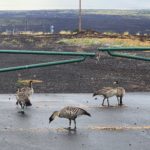Yesterday, at the direction of Governor Josh Green M.D., DLNR Chair Dawn Chang met with the principals of ABayKitties, the organization that has provided cat food to feeding stations at the Queens’ Marketplace.
Last week, property owner Alexander & Baldwin (A&B) removed the feeders after learning that a number of nēnē were eating the cat food.
In Chair Chang’s meeting with ABayKitties, she reiterated that the DLNR is required by law to protect nēnē, an endangered species under state law, and a threatened species under the federal Endangered Species Act. She also explained that when nēnē eat cat food, they can become sick and even die. Toxoplasmosis, a disease carried by cats, can also kill birds and critically endangered Hawaiian monk seals. Feral cats are among the most prolific predators of numerous near-extinct native forest birds.
Chang also told ABayKitties that she appreciates their passion but pointed out that native Hawaiians, numerous conservation organizations, and many local residents strongly support the protection of nēnē and other native animals, birds, and mammals. Feeding wildlife like nēnē can ‘habituate’ them to being around people which leads to more frequent car strikes, and even the abduction of young birds, as happened in Hilo last month.
Dozens of e-mails and phone calls received by DLNR and A&B show widespread support for stopping the feeding of feral cats.
While there have been no recent statewide surveys of the feral cat population, estimates put the number into the hundreds of thousands. On Hawai‘i Island, a 2021 survey of the nēnē population puts the number of birds at only 1,074. Statewide, the same survey indicated a population of 3,881.
During an April 11 protest by feral cat advocates, two women were cited for the illegally taking an endangered or threatened species. Those citations will require court appearances next month. Private property owners such as A&B have the right to decide what kinds of activities are permitted on their lands.
Chang shared that DLNR will be ramping up community education efforts. In addition, the DLNR Division of Forestry and Wildlife (DOFAW) is preparing informational flyers to distribute to property owners and individuals to educate people about how to avoid harming nēnē. The department has been in regular contact with area legislators who want to find a permanent solution and is also arranging meetings with Hawai‘i County and with humane societies, to work collaboratively.
DLNR Photo
